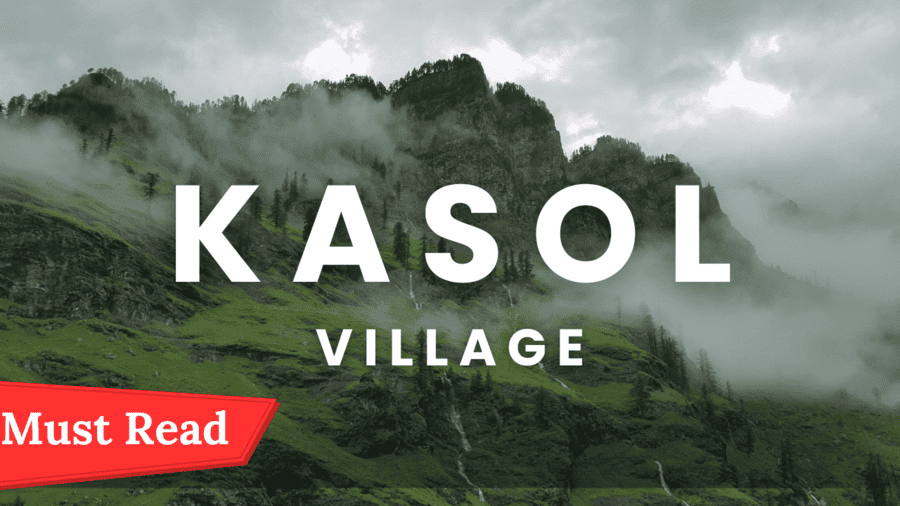Reading Time: 8 minutes

India has thousands of waterfalls, but there are some hidden gems that even seasoned travelers are not familiar with. Having visited off-the-beaten-path places of our beloved country, I’ve found waterfalls so beautiful that people keep them hidden from tourists. Here, I’m sharing these secrets with fellow travelers who visit Sites to Explore.
Visiting India’s varied landscapes, I’ve come across waterfalls that no travel brochure talks about. These waterfalls have something unique to present – an experience to view unblemished beauty with no tourists in throngs clicking selfies every two seconds.
What makes these waterfalls unique is not so much their beauty. It’s the trip there, what the locals have to share with you, and the experience of finding something not yet touched by mass tourism
Why These Waterfalls Remain Hidden
Most travelers stick to famous destinations like Jog Falls or Elephant Falls. But the real magic happens when you venture off the beaten path. Local communities often protect these areas because they understand that excessive tourism can harm delicate ecosystems.
Important Note: When visiting these locations, please respect local customs and the environment. Leave no trace behind and always ask permission from local communities.
1. Jogini Falls, Himachal Pradesh – The Sacred Cascade
Location Details
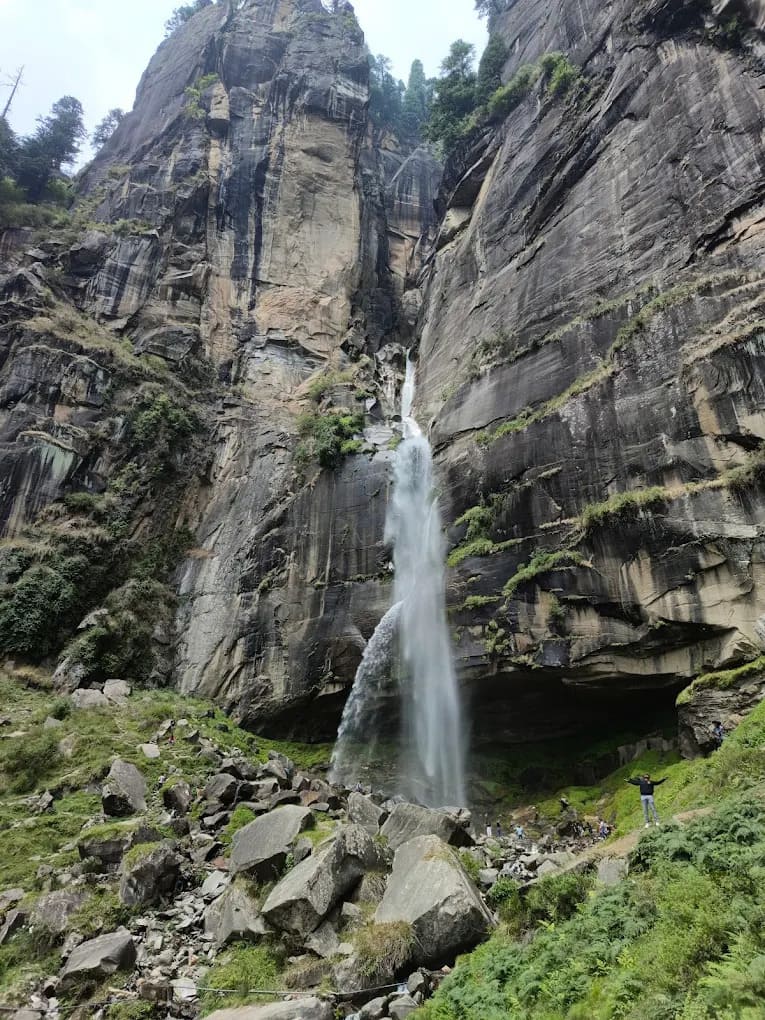
Hidden just 3 kilometers from Vashisht village near Manali, Jogini Falls drops 160 feet through rocky cliffs. Most tourists visiting Manali never discover this gem because locals don’t actively promote it.
Location : Google Map Link
Why Locals Keep It Quiet
This waterfall holds religious significance for the local community. They believe the water has healing properties, and excessive tourism might disturb the spiritual energy of the place.
Best Time to Visit
April to June offers the best water flow, while September to November provides clear mountain views. Avoid monsoon season due to slippery trails.
Key Points
- Height: 160 feet cascade through rocky cliffs
- Distance from Manali: 3 kilometers from Vashisht village
- Religious significance for local community
- Healing properties believed by locals
- Trek duration: 45 minutes through apple orchards
Complete Budget Breakdown:
| Expense Category | Budget Option | Mid-Range Option |
|---|---|---|
| Delhi to Manali (Bus) | ₹800-1,200 | ₹1,500-2,000 |
| Manali to Vashisht (Local Bus) | ₹50-100 | ₹200-300 (Taxi) |
| Accommodation (Per Night) | ₹800-1,500 | ₹2,000-3,500 |
| Food (Per Day) | ₹200-400 | ₹500-800 |
| Total for 2 Days | ₹2,500-4,000 | ₹5,000-7,500 |
Step-by-Step Directions:
- Reach Manali: Take overnight bus from Delhi (12-14 hours) or fly to Kullu airport then drive
- Local Transport: Board local bus from Manali bus stand to Vashisht village (15 minutes ride)
- Starting Point: Begin trek from Vashisht Temple area – look for trail markers
- Trail Route: Follow path through apple orchards → pine forest section → rocky terrain
- Final Approach: Last 10 minutes involves careful rock climbing to reach viewpoint
- Return: Same route back, allow 30 minutes for descent
How to Reach
Take a local bus from Manali to Vashisht village. From there, follow the trail markers for about 45 minutes through apple orchards and pine forests.
2. Kune Falls, Maharashtra – The Triple Drop Wonder
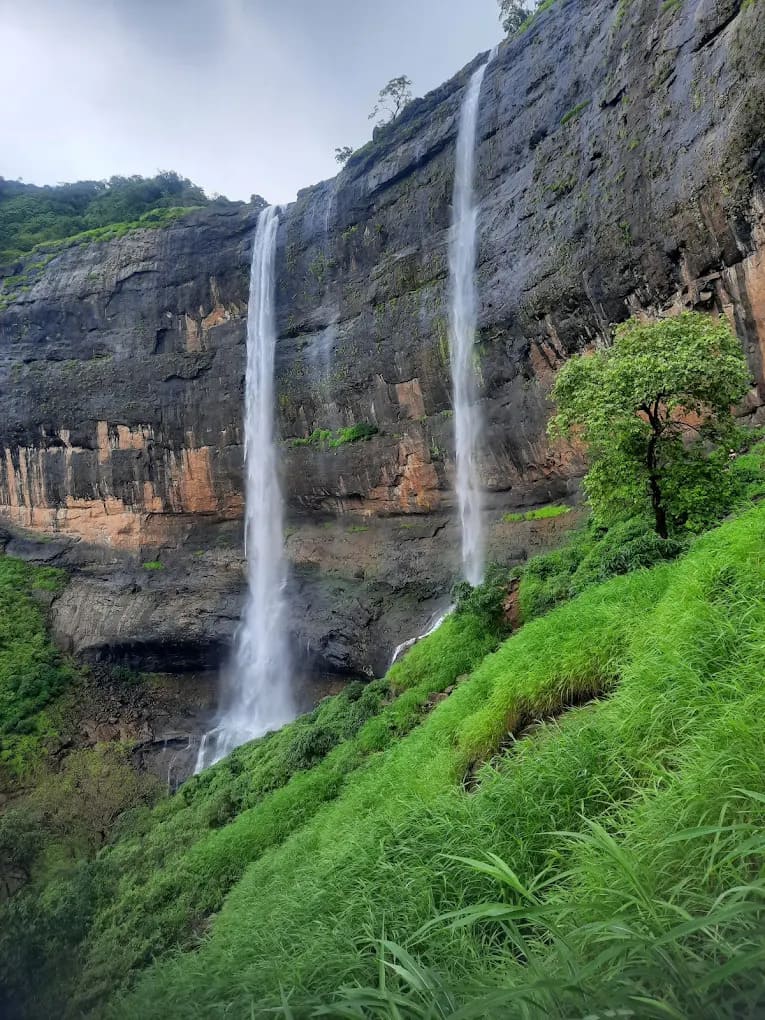
Location Details
Located near Lonavala, Kune Falls creates three distinct tiers as water cascades down 200 meters. Unlike crowded Bhushi Dam, this waterfall remains peaceful even during peak season.
Location : Google Map Link
Why It Stays Hidden
Local villagers in Khandala area prefer directing tourists to more accessible spots. They worry that Kune Falls’ narrow approach road can’t handle heavy traffic.
Perfect Timing
July to September brings the falls to life with monsoon rains. The three-tier structure becomes most visible during this period.
Key Highlights:
- Unique feature: Three distinct tiers dropping total 200 meters
- Location: Near Lonavala but away from tourist crowds
- Best visibility: July to September during monsoon season
- Access: Narrow road keeps heavy traffic away
- Alternative: Perfect substitute for crowded Bhushi Dam
- Photography: Each tier offers different photo opportunities
Complete Budget Breakdown:
| Expense Category | Budget Option | Mid-Range Option |
|---|---|---|
| Mumbai to Lonavala (Train) | ₹100-200 | ₹300-500 (AC) |
| Local Transport to Falls | ₹300-500 | ₹800-1,200 |
| Accommodation (Per Night) | ₹1,000-2,000 | ₹3,000-5,000 |
| Food (Per Day) | ₹300-500 | ₹800-1,200 |
| Total for 1-2 Days | ₹2,000-3,500 | ₹5,500-8,500 |
Step-by-Step Directions:
- Train Journey: Take local train from Mumbai CST to Lonavala station (2.5 hours)
- Reach Khandala: Hire auto-rickshaw from Lonavala to Khandala area
- Find Access Road: Look for small road near Khandala railway station
- Follow Signs: Drive/walk following “Rajmachi Village” direction boards
- Parking: Park at designated area before narrow trail begins
- Final Trek: 20-minute walk on marked trail through forest
- Viewing Points: Multiple spots offer views of all three tiers
Getting There
Drive towards Khandala from Lonavala. Take the small road near railway station and follow signs for “Rajmachi Village.” Park your vehicle and take a 20-minute trek.
Pro Tip from Sites to Explore: Always inform someone about your travel plans when visiting remote waterfalls. Carry enough water and snacks, as these locations rarely have shops nearby.
3. Chinnakanal Falls, Kerala – The Mist-Covered Beauty
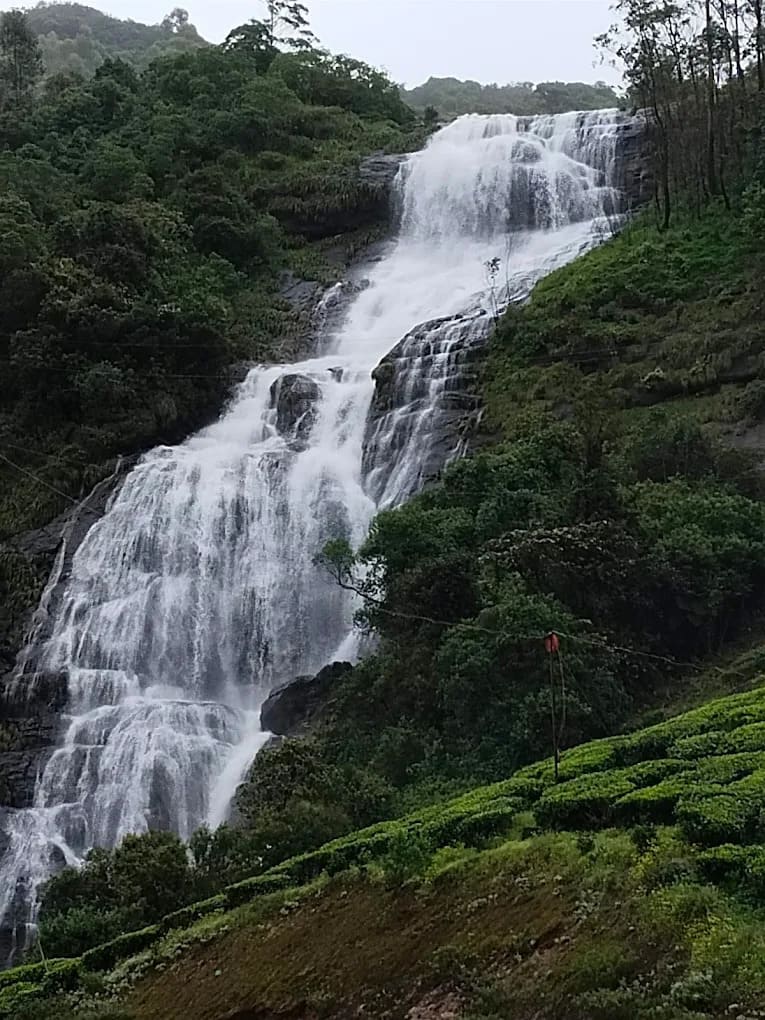
Location Details
Situated 18 kilometers from Munnar, Chinnakanal Falls flows through spice plantations and dense forests. The waterfall earned its name from the constant mist that surrounds the area.
Local Perspective
Spice plantation workers discovered this waterfall decades ago. They keep it relatively unknown because increased foot traffic could damage the delicate spice plants growing nearby.
Ideal Season
October to March offers pleasant weather and clear views. The waterfall maintains good flow throughout the year due to the surrounding plantation irrigation.
Key Highlights:
- Distance: 18 kilometers from famous Munnar hill station
- Unique setting: Flows through aromatic spice plantations
- Natural phenomenon: Constant mist creates magical atmosphere
- Water source: Year-round flow due to plantation irrigation
- Flora: Cardamom, pepper, and tea plants surround the area
- Best season: October to March for pleasant weather
Complete Budget Breakdown:
| Expense Category | Budget Option | Mid-Range Option |
|---|---|---|
| Kochi to Munnar (Bus) | ₹150-300 | ₹500-800 (Taxi) |
| Munnar to Falls Transport | ₹400-600 | ₹800-1,200 |
| Accommodation (Per Night) | ₹1,200-2,500 | ₹3,500-6,000 |
| Food (Per Day) | ₹250-450 | ₹600-1,000 |
| Total for 2-3 Days | ₹3,500-5,500 | ₹7,000-11,000 |
Step-by-Step Directions:
- Reach Munnar: Fly to Kochi airport, then bus/taxi to Munnar (4 hours)
- Take Highway: Drive on Munnar-Thekkady road towards Thekkady
- Distance Marker: After exactly 15 kilometers, look for landmarks
- Find Tea Shop: Locate “Mist View Point” tea shop on roadside
- Trail Start: Walking path begins directly behind the tea shop
- Plantation Walk: 30-minute trek through spice plantations
- Final Approach: Follow sound of water through cardamom plants
Route Information
Take the Munnar-Thekkady road. After 15 kilometers, look for a small tea shop called “Mist View Point.” The waterfall trail starts from behind this shop.
4. Bamson Falls, Uttarakhand – The Forest Secret
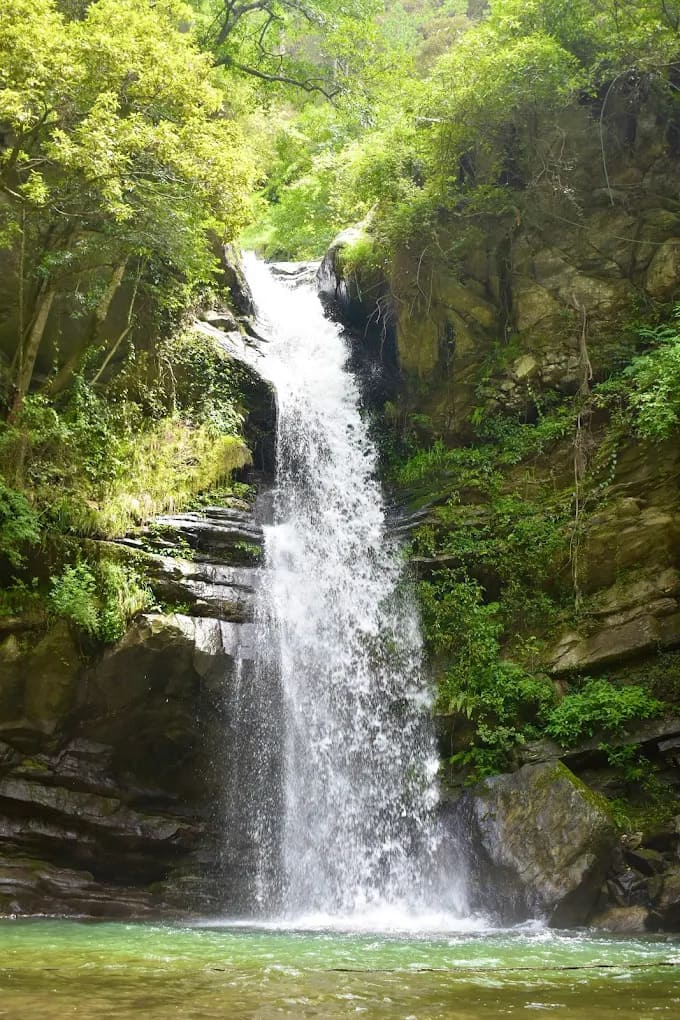
Location Details
Hidden deep within Jim Corbett National Park region, Bamson Falls drops 50 feet into a natural pool surrounded by sal trees. Wildlife often visits this water source during early morning hours.
Location : Google Map Link
Why Few Know About It
Forest department officials don’t promote this location heavily because it lies in a sensitive wildlife corridor. They prefer keeping visitor numbers low to protect animal movement patterns.
Key Highlights:
- Location: Deep within Jim Corbett National Park region
- Height: 50 feet drop into crystal-clear natural swimming pool
- Wildlife: Elephants, deer, and birds frequent this water source
- Trees: Surrounded by towering sal trees and bamboo groves
- Best time: November to February for wildlife sightings
- Restriction: Requires forest department guide for safety
Complete Budget Breakdown:
| Expense Category | Budget Option | Mid-Range Option |
|---|---|---|
| Delhi to Ramnagar (Train) | ₹300-600 | ₹800-1,200 |
| Park Entry Fees | ₹600-1,200 | ₹600-1,200 |
| Mandatory Guide Fees | ₹1,500-2,500 | ₹2,500-4,000 |
| Forest Accommodation | ₹2,000-4,000 | ₹4,000-8,000 |
| Food (Per Day) | ₹400-600 | ₹800-1,200 |
| Total for 2-3 Days | ₹6,000-10,000 | ₹10,000-16,000 |
Step-by-Step Directions:
- Reach Ramnagar: Take train from Delhi to Ramnagar (5-6 hours)
- Park Entry: Enter Corbett National Park through Dhangadhi gate
- Guide Assignment: Hire mandatory forest department guide at gate
- Wildlife Route: Follow designated wildlife corridor trail (2-3 hours)
- Safety Protocol: Guide ensures safe passage around elephant areas
- Forest Trek: Walk through sal forest following animal paths
- Final Stretch: Last 500 meters requires careful approach due to wildlife
Best Visiting Time
November to February provides excellent weather and higher chances of wildlife sightings. Avoid summer months due to extreme heat.
Access Route
Enter through Corbett’s Dhangadhi gate. Hire a local guide from the forest department – they know the exact trail and can ensure your safety around wildlife.
5. Hirni Falls, Odisha – The Tribal Guardian
Location Details
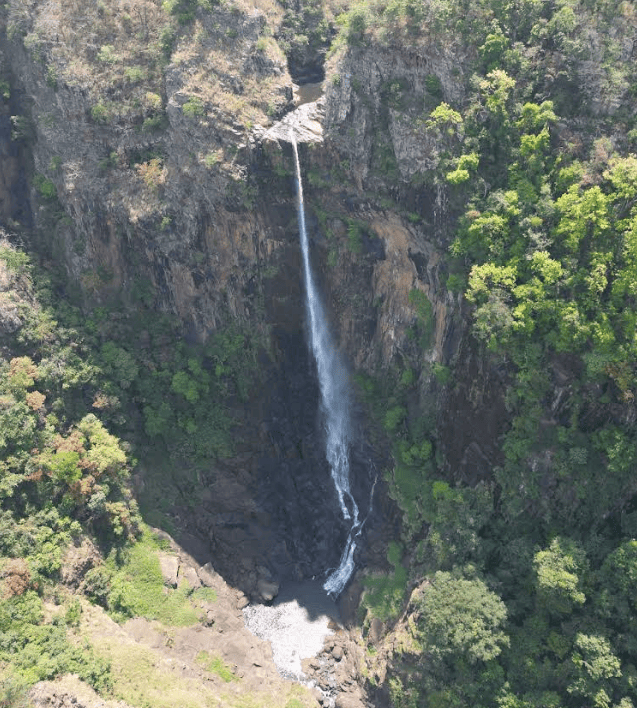
Located in the Mayurbhanj district, Hirni Falls cascade through dense Simlipal forests. The waterfall creates natural swimming pools that tribal communities have used for generations.
Location : Google Map Link
Cultural Significance
Local tribal communities consider this waterfall sacred and perform seasonal rituals here. They’re selective about sharing its location to preserve their cultural practices.
Key Highlights:
- Location: Mayurbhanj district within dense Simlipal forests
- Cultural value: Sacred site for local tribal communities
- Natural pools: Multiple swimming areas formed by cascade
- Rituals: Seasonal ceremonies performed by tribal groups
- Access: Requires permission from community elders
- Guide necessity: Tribal guide mandatory for forest navigation
Complete Budget Breakdown:
| Expense Category | Budget Option | Mid-Range Option |
|---|---|---|
| Bhubaneswar to Baripada | ₹200-400 | ₹500-800 |
| Jeep to Nawana Village | ₹800-1,200 | ₹1,200-2,000 |
| Tribal Guide (Per Day) | ₹1,000-1,500 | ₹1,500-2,500 |
| Village Homestay | ₹500-1,000 | ₹1,000-2,000 |
| Simple Meals (Per Day) | ₹150-300 | ₹300-500 |
| Total for 2-3 Days | ₹3,500-5,500 | ₹5,500-8,500 |
Step-by-Step Directions:
- Reach Baripada: Fly to Bhubaneswar, then bus to Baripada town (4 hours)
- Village Transport: Hire local jeep from Baripada to Nawana village
- Community Permission: Meet tribal elders for cultural protocol and permission
- Guide Selection: Community assigns experienced tribal guide
- Forest Entry: Trek 2 kilometers through dense Simlipal forest
- Traditional Path: Guide follows ancestral routes used by tribal people
- Sacred Approach: Final approach respects cultural and spiritual significance
Perfect Season
June to September brings maximum water flow. Post-monsoon months (October-November) offer safer trekking conditions.
Reaching the Falls
Travel to Baripada town first. From there, hire a local jeep to Nawana village. The final 2-kilometer trek requires a tribal guide who knows the forest paths.
Respect Local Culture: When visiting tribal areas, always seek permission from community elders. Consider hiring local guides to support the community economically.
6. Langshiang Falls, Meghalaya – The Living Root Wonder
Location Details
Tucked away in West Khasi Hills, Langshiang Falls drops 300 feet through limestone cliffs. Living root bridges created by local Khasi people lead to the best viewing points.

Location: Google Map Link
Why It Remains Secret
Khasi villagers built living root bridges over the decades to access this waterfall. They worry that too many visitors might damage these delicate bio-engineering marvels.
Optimal Timing
May to September offers full water flow and lush green surroundings. The living root bridges are strongest during these months.
Key Highlights:
- Height: Spectacular 300 feet drop through limestone cliffs
- Unique access: Living root bridges created by Khasi people
- Bio-engineering: Bridges grown over decades using tree roots
- Challenge level: Difficult 3-hour descent, 4-5 hour return climb
- Ecosystem: Extremely delicate environmental balance
- Cultural heritage: Traditional Khasi engineering methods
Complete Budget Breakdown:
| Expense Category | Budget Option | Mid-Range Option |
|---|---|---|
| Guwahati to Cherrapunji | ₹300-500 | ₹800-1,200 |
| Local Guide (Per Day) | ₹1,500-2,500 | ₹2,500-4,000 |
| Village Homestay | ₹800-1,500 | ₹1,500-3,000 |
| Traditional Meals | ₹200-400 | ₹400-700 |
| Equipment Rental | ₹300-500 | ₹500-800 |
| Total for 2-3 Days | ₹4,000-6,500 | ₹7,000-11,000 |
Step-by-Step Directions:
- Reach Cherrapunji: Fly to Guwahati, drive to Cherrapunji (3 hours)
- Village Access: Drive to Nongriat village from Cherrapunji center
- First Bridge: Begin descent crossing famous double-decker living root bridge
- Second Bridge: Continue to second living root bridge crossing
- Forest Descent: Trek through pristine forest paths (total 3 hours down)
- Waterfall Approach: Final approach through rocky terrain
- Return Journey: Challenging 4-5 hour climb back up (prepare for exhaustion)
Journey Details
Drive to Nongriat village from Cherrapunji. The descent involves crossing two living root bridges and takes about 3 hours. Return journey is quite challenging.
7. Vazhachal Falls, Kerala – The Elephant’s Secret
Location Details
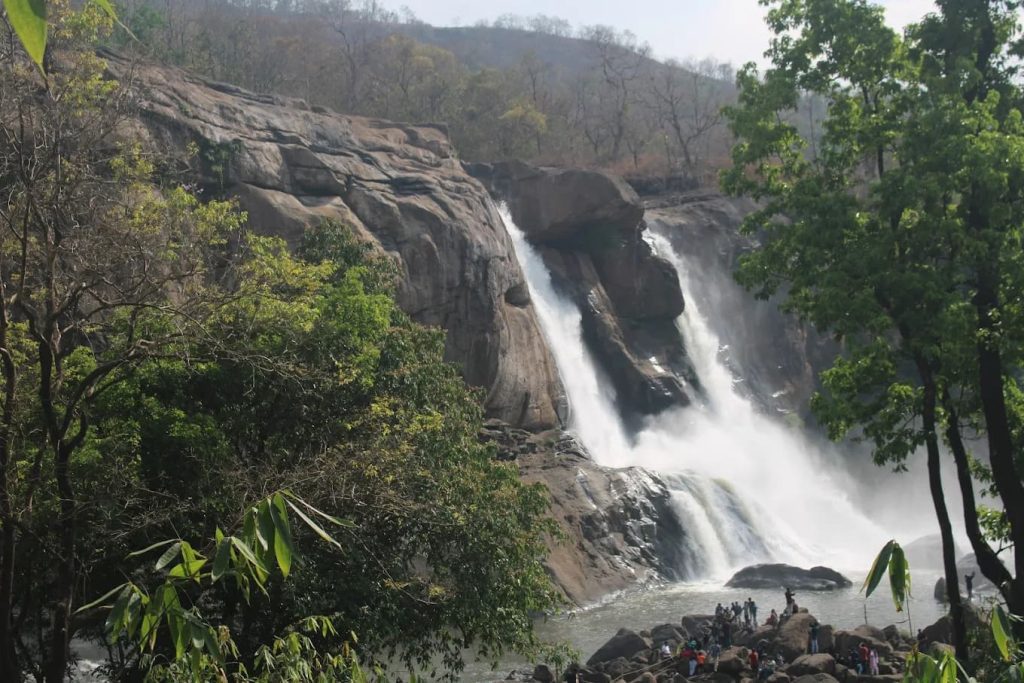
Hidden within the Sholayar forest range, Vazhachal Falls flows year-round through pristine wilderness. Wild elephants frequent this area, creating natural paths to the waterfall.
Location: Google Map Link
Local Wisdom
Forest communities learned about this waterfall by following elephant trails. They keep it quiet because human presence can disturb elephant migration routes.
Best Period
December to April provides safe wildlife viewing and comfortable trekking weather. Monsoon season makes trails dangerous due to elephant activity.
Key Highlights:
- Location: Within pristine Sholayar forest range
- Water flow: Year-round flow through untouched wilderness
- Wildlife corridor: Major elephant migration route intersection
- Natural paths: Elephants create trails leading to waterfall
- Safety requirement: Forest department guide absolutely mandatory
- Best season: December to April for safe wildlife viewing
Complete Budget Breakdown:
| Expense Category | Budget Option | Mid-Range Option |
|---|---|---|
| Kochi to Chalakudy | ₹100-200 | ₹300-500 |
| Chalakudy to Athirappilly | ₹200-400 | ₹500-800 |
| Forest Guide (Mandatory) | ₹2,000-3,000 | ₹3,000-5,000 |
| Forest Lodge Stay | ₹2,500-4,000 | ₹4,000-7,000 |
| Kerala Meals (Per Day) | ₹300-500 | ₹600-1,000 |
| Total for 2-3 Days | ₹6,500-9,500 | ₹10,000-16,000 |
Step-by-Step Directions:
- Airport Access: Land at Kochi International Airport
- Reach Chalakudy: Take bus or taxi to Chalakudy town (1.5 hours)
- Drive to Base: Continue from Chalakudy to Athirappilly area
- Forest Checkpoint: Report to forest department checkpoint for permits
- Guide Assignment: Receive trained guide familiar with elephant territories
- Safe Route: Guide navigates elephant-safe paths through forest
- Variable Trek: Duration 2-4 hours depending on current elephant activity
- Wildlife Protocol: Strict adherence to guide instructions for safety
Access Information
Start from Chalakudy town and drive to Athirappilly. From there, hire a forest department guide who can safely navigate elephant territories.
Essential Tips for Waterfall Hunting
After exploring these hidden gems, I’ve learned several important lessons that every waterfall enthusiast should know:
Safety First
Remote waterfalls often lack safety barriers or warning signs. Always trek with companions and inform local authorities about your plans. Carry first aid supplies and emergency contact numbers.
Seasonal Planning
Each waterfall has its personality throughout the year. Monsoon months bring maximum flow but also increased danger from slippery rocks and flash floods. Post-monsoon periods often provide the perfect balance of water flow and safety.
Essential Information for All Waterfalls
What to Pack (Complete Checklist):
- Footwear: Waterproof trekking shoes with good grip
- Clothing: Quick-dry clothes, extra set in waterproof bag
- Safety Items: First aid kit, emergency whistle, flashlight
- Food & Water: Energy bars, nuts, minimum 2 liters water per person
- Electronics: Waterproof phone case, power bank, camera
- Documents: ID proof, emergency contact numbers, guide contact
- Cash: Sufficient local currency for guides and emergencies
Safety Guidelines:
- Never trek alone – always go in groups of minimum 3 people
- Inform family/friends about exact travel plans and expected return
- Follow local guide instructions without questioning
- Don’t swim in unknown water bodies without local advice
- Respect cultural customs and sacred spaces
- Carry emergency medicines for common ailments
- Check weather conditions before starting journey
Best Photography Tips:
- Golden Hours: Early morning (6-8 AM) and late afternoon (4-6 PM)
- Equipment: Waterproof camera bag, extra batteries, lens cleaning cloth
- Monsoon Season: Best water flow but challenging weather conditions
- Post-Monsoon: Clearer visibility and safer trekking conditions
- Respect Privacy: Ask permission before photographing local people
- Sacred Spaces: Some areas may have photography restrictions
Budget-Saving Strategies:
- Travel in Groups: Share guide fees and transportation costs
- Off-Season Travel: Lower accommodation rates and fewer crowds
- Public Transport: Use buses and trains instead of private taxis
- Local Homestays: Authentic experience at budget-friendly rates
- Advance Booking: Better rates for accommodation and transport
- Local Food: Eat at local restaurants for authentic and cheap meals
- Group Packages: Many guides offer group discounts
Cultural Sensitivity Guidelines:
- Always seek permission from local communities before visiting
- Respect religious and cultural practices of tribal areas
- Don’t disturb or damage natural habitats
- Follow “Leave No Trace” principles strictly
- Support local economy by hiring local guides and buying local products
- Learn basic greetings in local languages
- Dress modestly, especially in tribal and religious areas
Total Budget Summary (Per Person):
| Travel Style | Cost Range per Waterfall | Best For |
|---|---|---|
| Budget Travel | ₹2,500 – ₹5,500 | Students, backpackers, solo travelers |
| Mid-Range Travel | ₹4,000 – ₹7,500 | Families, couples, comfort seekers |
| Comfortable Travel | ₹6,500 – ₹10,000 | Luxury travelers, elderly, groups |
Note: Prices are approximate and may vary based on season, group size, and current market rates.
Sites to Explore – Your Gateway to Hidden India
For personalized travel planning, detailed itineraries, and expert guidance on visiting these hidden waterfalls, contact our travel specialists.
Visit: https://www.sitestoexplore.com/contact
Discover the extraordinary. Experience the unexplored.
Local Connections
Building relationships with local communities opens doors to hidden treasures. Spend time in village tea shops, talk to local guides, and always ask permission before exploring sensitive areas.
Photography Ethics: These locations offer incredible photo opportunities, but remember to respect the privacy of local people and sacred spaces. Some communities prefer certain areas remain unphotographed.
Supporting Local Communities
When you visit these hidden waterfalls, your presence can positively impact local communities. Here’s how to be a responsible traveler:
Hire local guides whenever possible. They know the safest routes, best viewing spots, and can share fascinating stories about each location. Stay in local homestays or guesthouses rather than chain hotels when available.
Purchase supplies from village shops instead of bringing everything from the cities. This small gesture supports local economies and helps communities see tourism as beneficial rather than disruptive.
Planning Your Waterfall Adventure
Each of these waterfalls requires different levels of preparation and fitness. Start with easier options like Jogini Falls or Kune Falls if you’re new to adventure travel. Graduate to more challenging locations like Langshiang Falls or Vazhachal Falls as you gain experience.
Create a waterfall bucket list and tackle one destination per trip. This approach allows you to fully appreciate each location rather than rushing through multiple spots.
Discovering India’s Hidden Water Treasures
These seven hidden waterfalls represent just a fraction of India’s undiscovered natural beauty. Each offers unique experiences, from spiritual moments at Jogini Falls to wildlife encounters at Vazhachal Falls.
Remember that with privilege comes responsibility. As travelers who discover these hidden gems, we must protect them for future generations. Practice sustainable tourism, respect local cultures, and share these locations responsibly.
At Sites to Explore, we believe that the best travel experiences happen when you step away from crowded tourist spots and connect with authentic local experiences. These waterfalls provide exactly that opportunity.
Have you discovered any hidden waterfalls during your travels? We’d love to hear your stories and experiences. Contact us to share your adventures or ask questions about planning your waterfall hunting expedition.
Start planning your next adventure to these incredible hidden waterfalls. Remember to travel responsibly, respect local communities, and leave only footprints behind.
Ready to Explore? Before heading out to any of these waterfalls, check current weather conditions and local regulations. Some locations may require special permits or have seasonal restrictions for visitor safety.
